

Essay Cover Letter
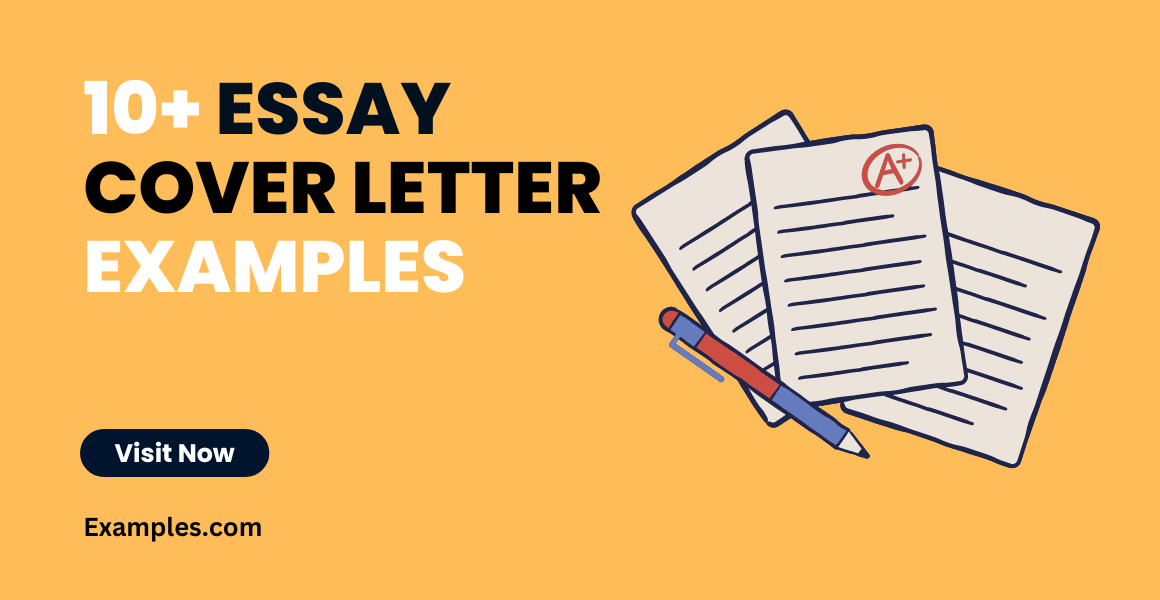
An Essay Cover Letter is more than a formality; it’s an opportunity to impress. Whether you’re submitting an academic essay or looking for a publication opportunity, the cover letter serves as your first impression. This article sheds light on what an Essay Cover Letter is, provides insightful examples, and offers valuable tips to make your cover letter stand out.
What is an Essay Cover Letter?
An Essay Cover Letter is a brief introduction accompanying an essay, typically submitted to an academic institution or a publication. It summarizes the content and purpose of the essay, highlights the writer’s qualifications, and expresses the intention behind submitting the essay. It’s a personalized note that connects the reader to the writer, setting the tone for the content that follows.
What is an Example of an Essay Cover Letter?
Here’s an generic cover letter example for an Essay Cover Letter tailored for an academic submission:
[Your Name] [Your Address] [City, State ZIP Code] [Email Address] [Phone Number] [Date]
[Professor’s Name] [Department] [University Name] [University Address] [City, State ZIP Code]
Dear [Professor’s Name],
I am submitting my essay entitled “[Title of the Essay]” for consideration in your [Course Name] class. This essay explores [Brief Summary of the Essay Content], drawing on [Methodology or Sources Used].
As a student majoring in [Your Major], I have thoroughly researched the subject matter and applied critical thinking skills to provide a comprehensive analysis of [Specific Topic]. I believe this essay aligns with the course objectives and will contribute valuable insights to the class discussions.
Please find the essay attached for your review. I look forward to receiving your feedback and am available for any questions or further clarification.
Thank you for considering my submission.
[Your Signature]
[Your Full Name] [Student ID]
This example outlines the essential elements of an effective Essay Cover Letter, maintaining a formal tone and providing specific details about the essay and the writer’s qualifications.
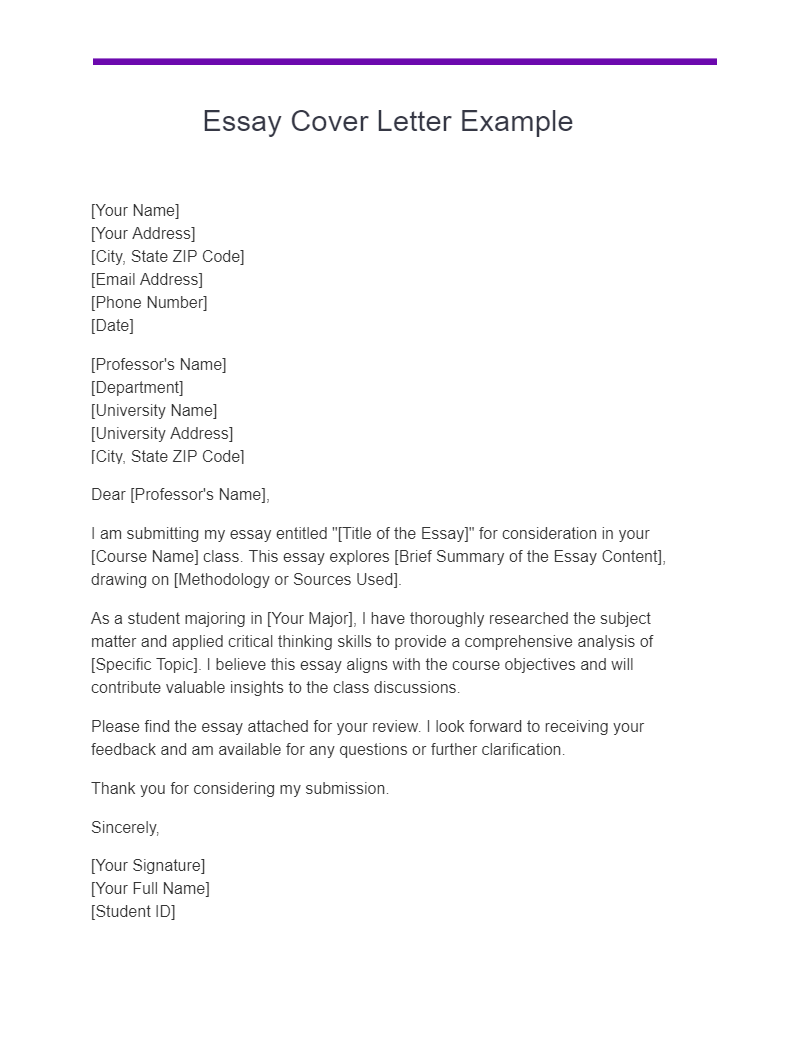
Size: 26 KB
Free Essay Cover Letters – Copy & Paste
Essay cover letter format.
This example represents the standard format that an Essay Cover Letter should follow. The below template can be customized according to your needs.
[Your Full Name] [Address] [City, State, ZIP Code] [Phone Number] [Email Address] [Date]
[Recipient’s Full Name] [Recipient’s Title] [Organization/University Name] [Address] [City, State, ZIP Code]
Dear [Recipient’s Name],
[Opening Paragraph: Introduction and reason for writing]
[Body Paragraph(s): Details about the essay, your qualifications, and why your essay fits the context]
[Closing Paragraph: Thank you note and contact information]
[Signature (if printed)] [Typed Full Name]
Customize the bracketed sections with your specific details. Make sure to include an introduction, details about the essay, and a closing thank you note.
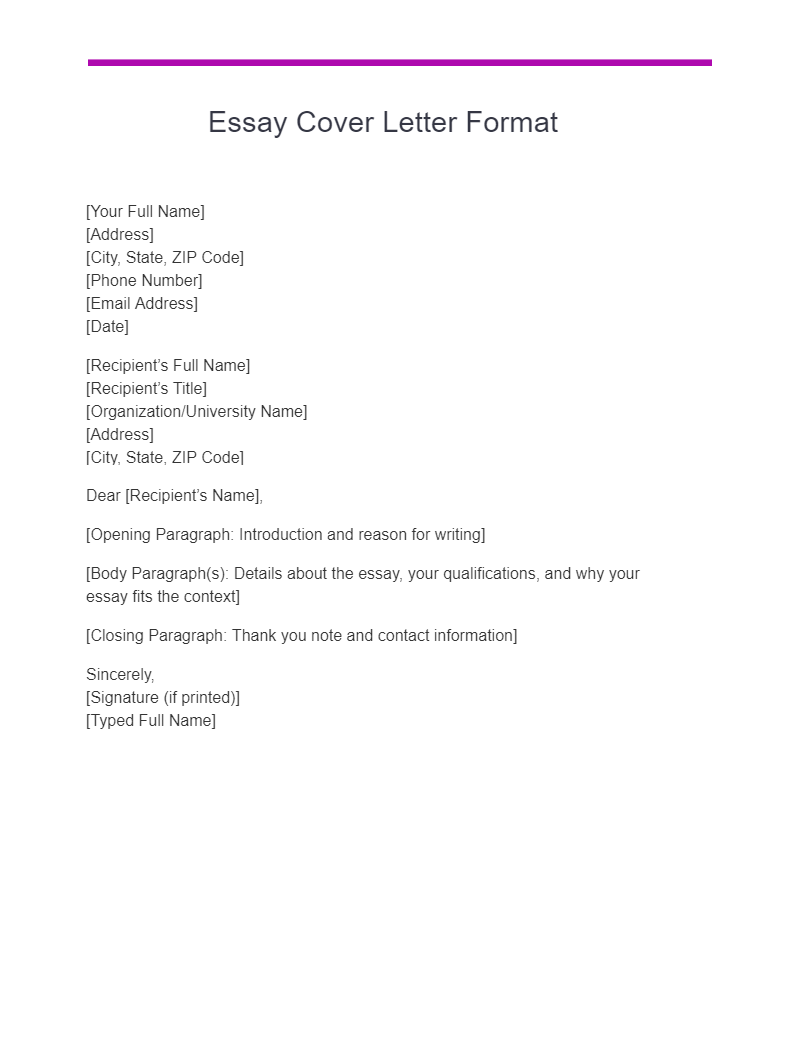
Sample Essay Cover Letter Example
This is a good cover letter sample that can be adapted to any essay submission.
Dear [Recipient’s Name],
I am writing to submit my essay titled “[Essay Title]” for [Purpose of Submission]. My essay explores [Topic], and I believe it offers a fresh perspective on [Specific Aspect].
[Body Paragraph detailing the approach, sources, and relevance of the essay]
Thank you for considering my work. I look forward to your feedback.
Best Regards, [Your Name]
This sample is adaptable. Fill in the brackets with specific details about your essay and the submission context.
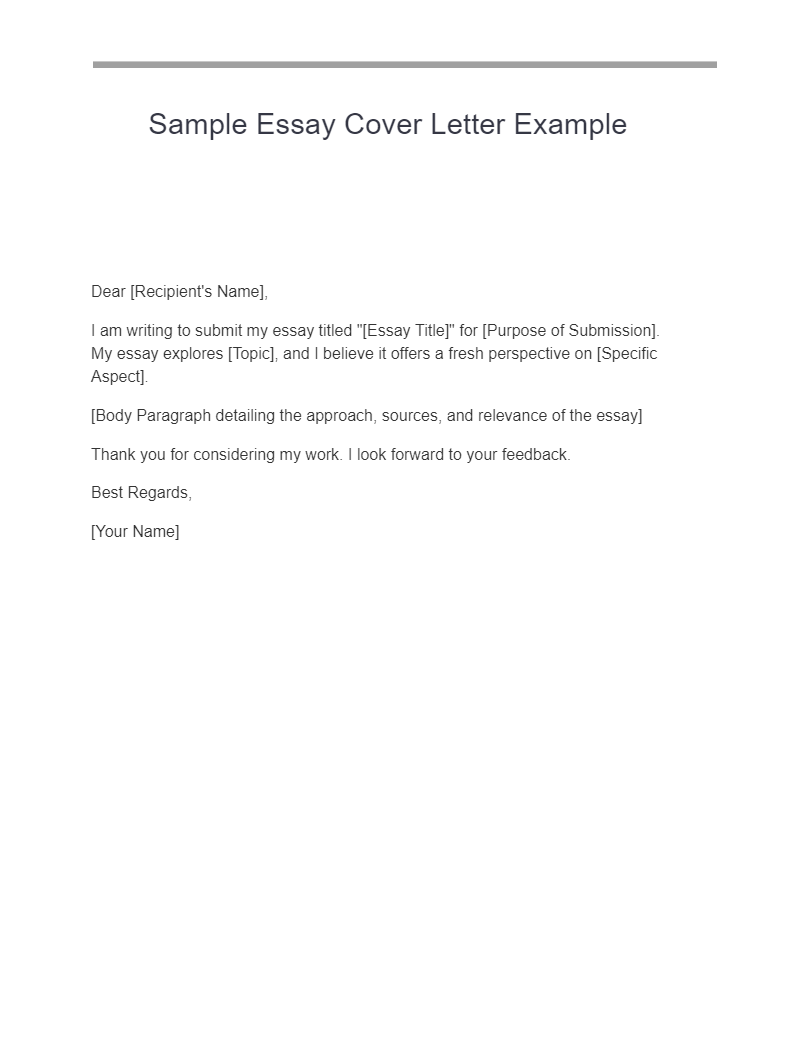
Size: 25 KB
Short Essay Cover Letter
Ideal for submissions with a strict word count limit.
Enclosed is my essay “[Essay Title],” written for [Purpose]. It delves into [Topic], and I hope it contributes to [Specific Field or Discussion].
Thank you, [Your Name]
This short version is perfect when brevity is required. It gets straight to the point but remains polite and professional.
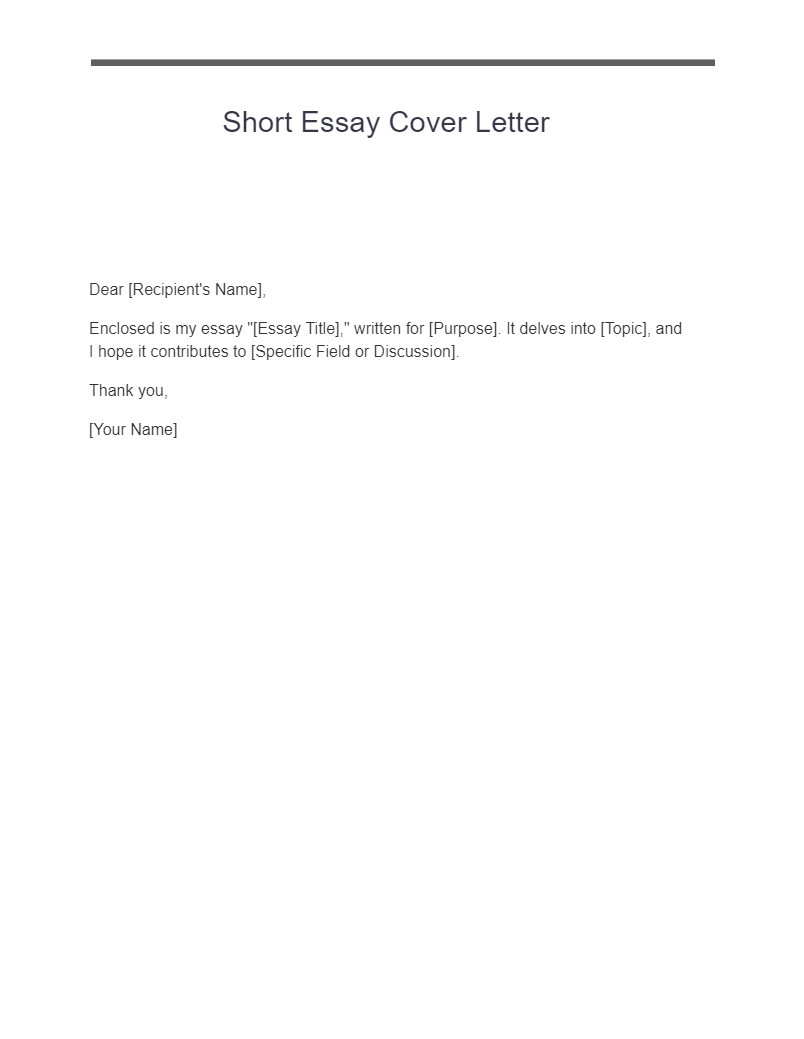
Size: 22 KB
Essay Cover Letter for College Student Example
Specifically designed cover letter for college students submitting essays for class or applications.
[Your Name] [College] [Address] [City, State ZIP Code] [Date]
[Professor’s Name] [Department] [College] [Address] [City, State ZIP Code]
I’m submitting my essay on [Subject] for your [Course Name]. As a [Major] student, I found this topic particularly intriguing because [Reason].
[Details about the essay and any specific request for feedback]
Thank you for your consideration.
Sincerely, [Your Name] [Student ID]
Customize this template to reflect the course details, your major, and specifics about your essay. It maintains a tone suitable for academic correspondence.
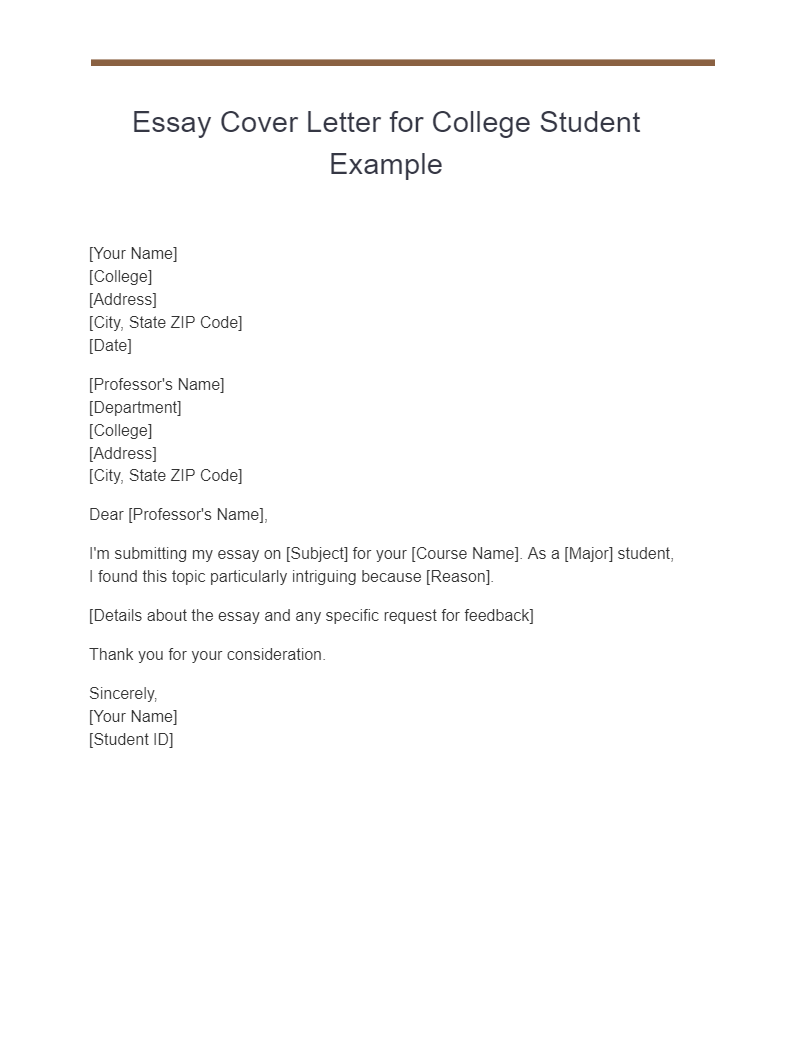
Size: 24 KB
MLA Style Essay Cover Letter Example
For submissions requiring MLA citation style.
[Your Name] [Professor’s Name] [Course] [Date]
[Title of Essay]
[Essay Introduction]
Sincerely, [Your Name]
This template is formatted according to the MLA style and should be used for submissions requiring this citation method.

Size: 21 KB
APA Style Essay Cover Letter Example
This is suitable for submissions that require APA formatting.
[Your Name] [Institution] [Address] [City, State ZIP Code] [Date]
[Recipient’s Name] [Title] [Organization] [Address] [City, State ZIP Code]
I am submitting my essay titled “[Essay Title],” written in accordance with the APA citation style, for [Purpose].
[Body Paragraphs detailing the essay, its relevance, and your qualifications]
Use this template for submissions that require adherence to the APA citation style.
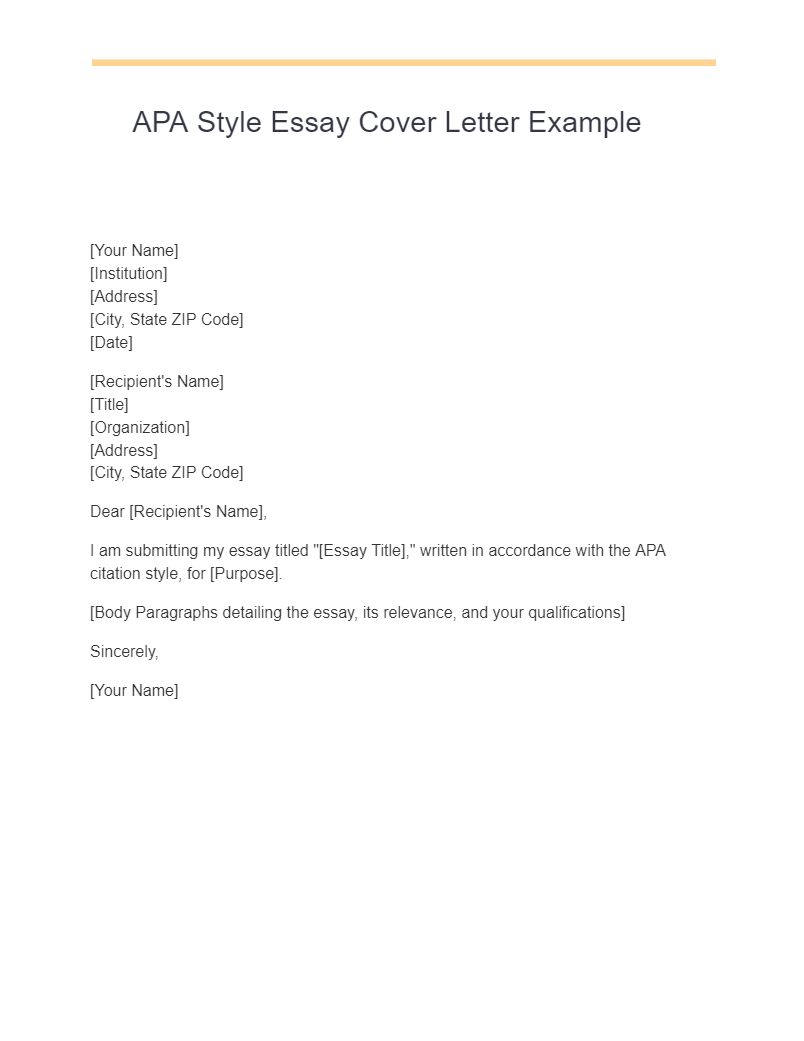
Simple Essay Cover Letter Example
This is a minimalist version suitable for any essay submission.
I’m submitting my essay “[Essay Title]” for [Purpose]. It examines [Topic] through [Methodology/Approach].
This simple version is versatile and can be used for various submission contexts.
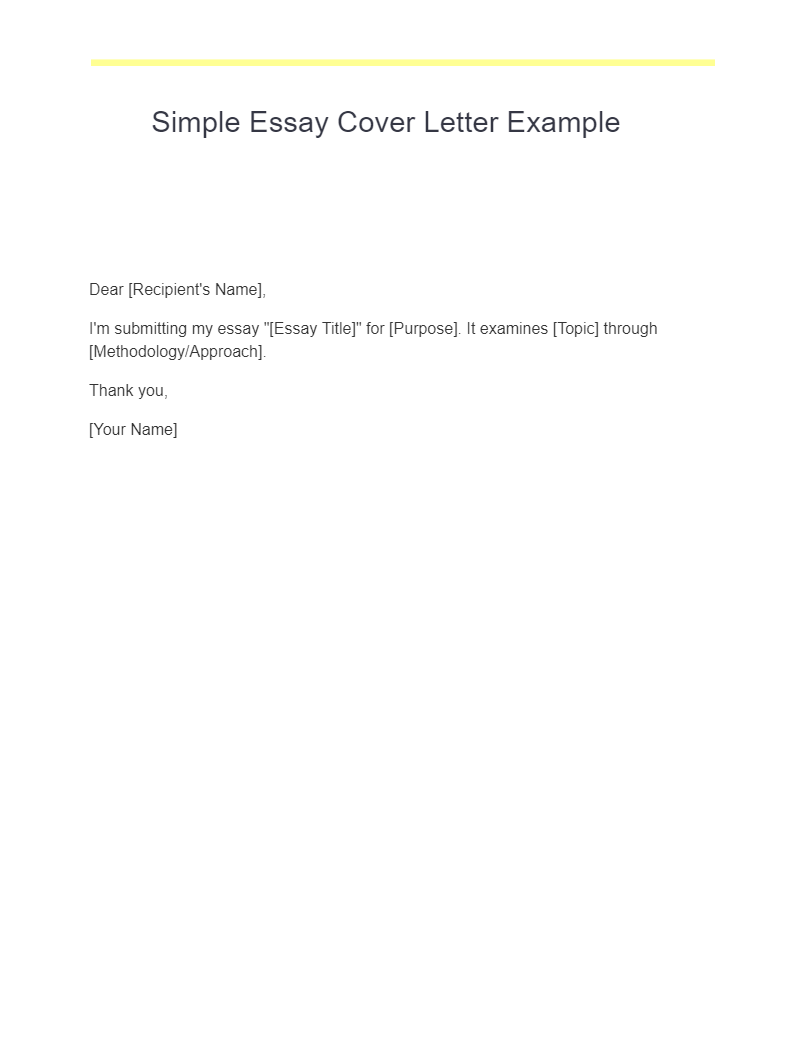
Size: 23 KB
Basic Essay Cover Letter Example
Another minimalist & basic cover letter template, focused on academic submissions.
[Your Name] [Address] [City, State ZIP Code] [Date]
Attached is my essay for your [Course Name], titled “[Essay Title].”
This basic format is tailored to academic submissions and maintains a formal tone.
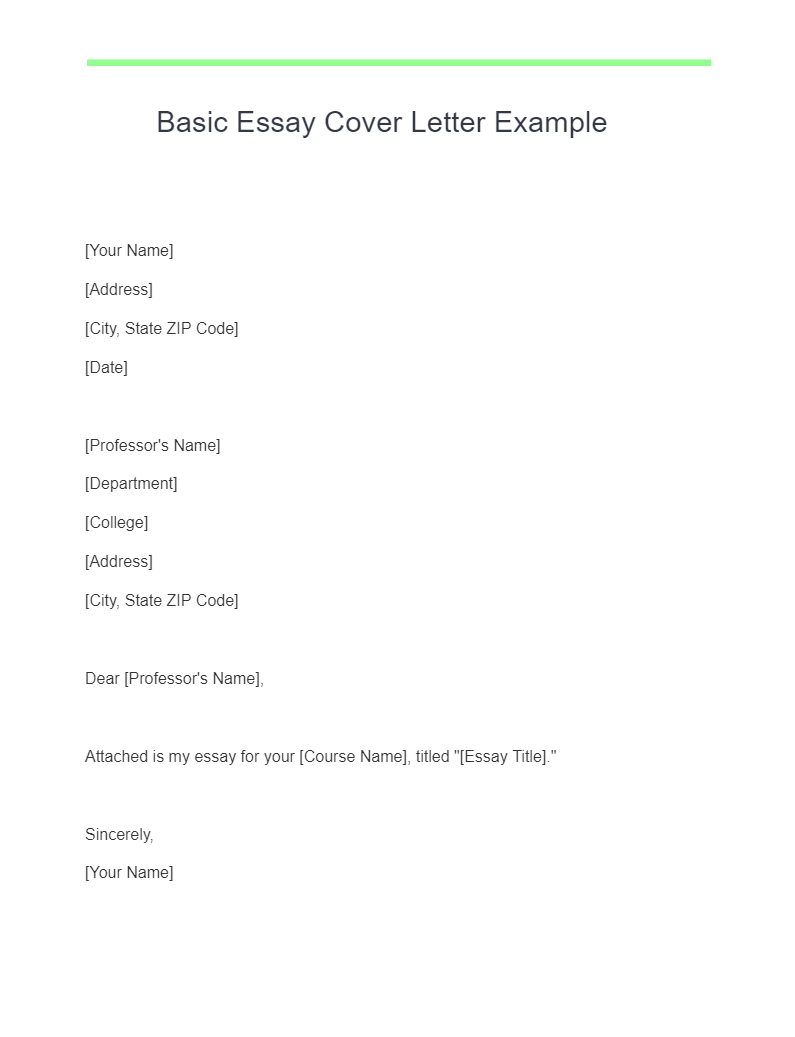
Essay Cover Letter for Admission Example
Ideal for students submitting essays as part of a college application.
[Your Name] [Address] [City, State ZIP Code] [Phone Number] [Email Address] [Date]
[Admission Officer’s Name] [College/University Name] [Address] [City, State ZIP Code]
Dear [Admission Officer’s Name],
I’m thrilled to submit my essay for consideration as part of my application to [College/University Name]. My essay, titled “[Essay Title],” reflects my passion for [Field of Study] and my commitment to [College/University Values or Goals].
[More details about the essay, your qualifications, and why you chose this particular institution]
Thank you for considering my application.
Sincerely, [Your Signature] [Your Full Name]
This template can be tailored to the specific college or university application, highlighting your alignment with the institution’s values or goals.
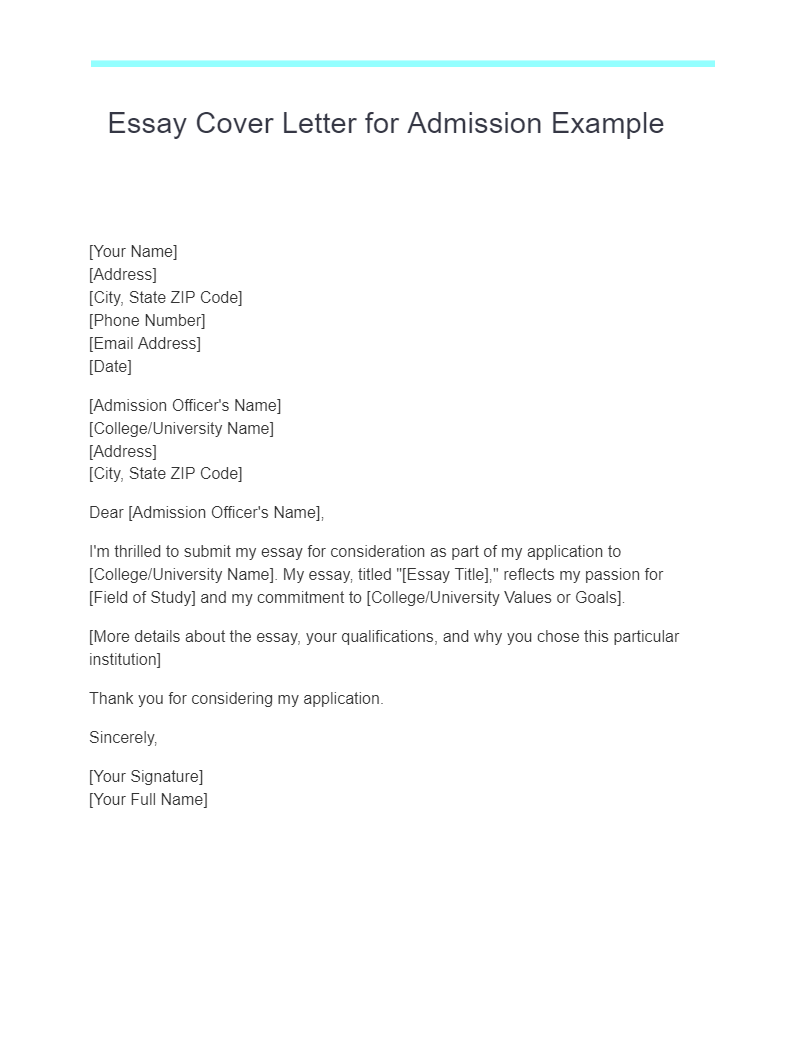
Persuasive Essay Cover Letter Example
For submitting persuasive essays specifically.
I am submitting my persuasive essay titled “[Essay Title].” This piece aims to convince readers about [Argument/Thesis] and is supported by [Evidence/Methodology].
[Further details about the essay, its relevance, and your qualifications]
Use this template when submitting a persuasive essay, emphasizing the argument and evidence.

History Essay Cover Letter Example
For history-related essays and submissions.
[Professor/Recipient’s Name] [Title/Department] [Institution/Organization] [Address] [City, State ZIP Code]
Dear [Professor/Recipient’s Name],
I am submitting my historical analysis titled “[Essay Title].” Drawing from primary sources, this essay explores [Historical Event or Period], offering new insights into [Specific Aspect or Perspective].
[More details about the essay, its relevance to the field of history, and your qualifications]
This template is tailored to history essays, with emphasis on the sources and historical analysis.
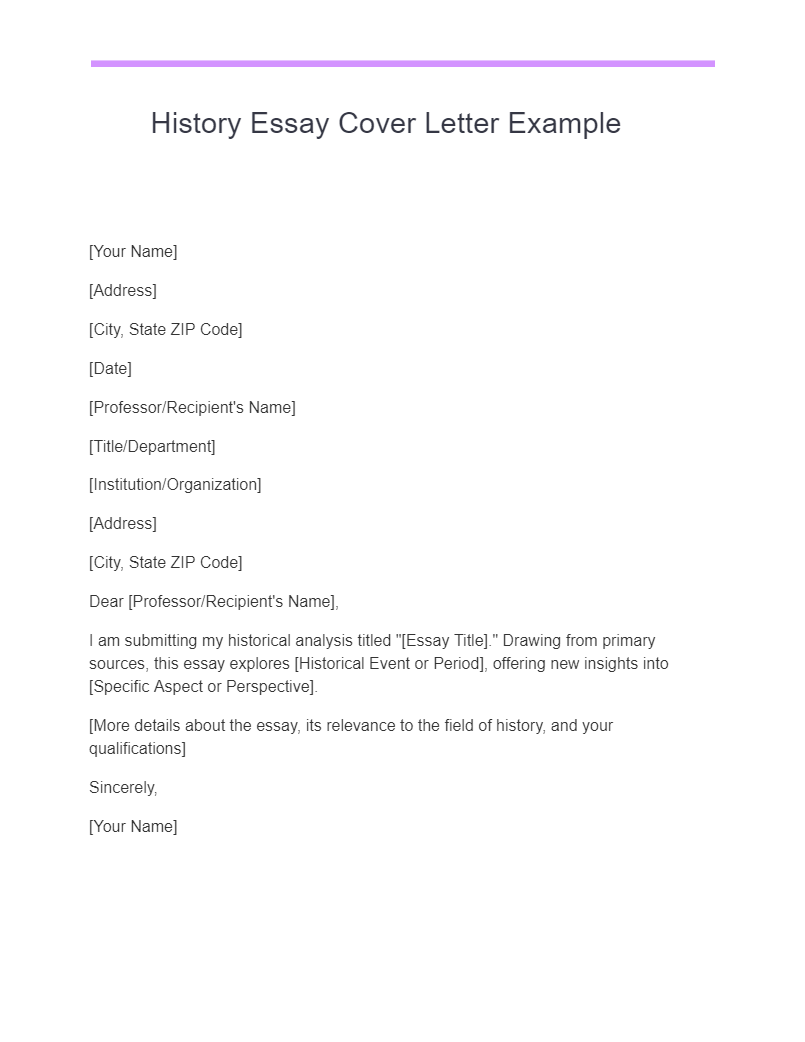
Size: 266 KB
Research Paper Cover Letter Example
This Research Paper cover letter is Ideal for research paper submissions to journals or academic conferences.
[Your Name] [Title] [Institution] [Address] [City, State ZIP Code] [Date]
[Editor’s Name] [Journal Name] [Address] [City, State ZIP Code]
Dear [Editor’s Name],
I am submitting my research paper titled “[Paper Title]” for consideration in [Journal Name]. My research focuses on [Research Area], and I believe it offers significant contributions to the field.
[Further details about the research, methodology, and relevance to the journal’s readership]
Sincerely, [Your Name] [Your Title] [Contact Information]
Use this template for research paper submissions, making sure to tailor it to the specific journal or conference requirements.
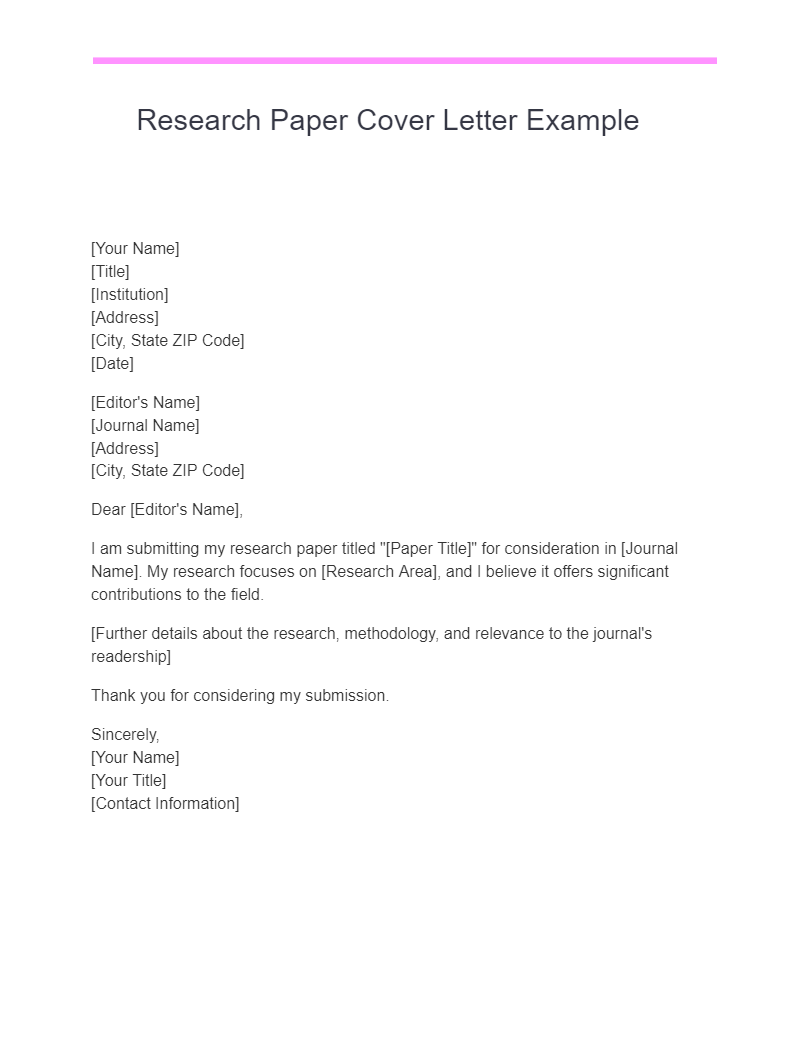
What do you write in an Essay Cover Letter?
An Essay Cover Letter is more than a formality; it’s a chance to present your essay in the best possible light. Here’s what to include:
– Your Contact Information: Always include your full name, address, phone number, and email so the recipient can easily reach you. – Recipient’s Information: Address the cover letter to a specific person, if possible, including their title and address. – Introduction: Briefly introduce yourself, your academic or professional background, and explain the purpose of your essay. – Summary of the Essay: Offer a concise summary of your essay’s main topic, argument, or thesis. Avoid revealing too much, but give the reader a taste of what’s to come. – Relevance: Detail why your essay is relevant to the reader, whether it’s a professor, admissions officer, or publication editor. – Your Qualification and Interest: Share your qualifications or experiences that make you the right person to write this essay, along with why the topic interests you. – A Closing Statement: Express gratitude for the reader’s time and consideration, and include information on how they can contact you. – Signature: Include a formal closing, followed by your signature (for a hard copy) or typed name (for an email).
How Do You Write a Cover Letter for an Essay?
Writing an Essay Cover Letter requires understanding and careful crafting. Here’s how you can write one:
– Identify the Audience: Know your reader and adjust your tone and content to match their expectations. – Choose the Right Format: Standard letter format works well, but make sure to adhere to any specific guidelines provided. – Write Clearly: Use clear and concise language without oversimplifying your points. – Highlight Key Points: Emphasize the primary arguments or findings without merely repeating the essay. – Express Your Passion and Relevance: Your interest in the topic should shine through, and the relevance of the essay should be clear to the reader. – Edit Thoroughly: Check for grammatical and spelling mistakes, and consider having someone else review it.
Tips for Writing an Essay Cover Letter
– Maintain Consistency: The cover letter’s style and tone should match the essay. – Avoid Redundancy: Don’t repeat the entire essay; summarize and complement it instead. – Use Proper Formatting: If your essay follows APA or MLA guidelines, mirror this in the cover letter. – End Strongly: Conclude with a respectful closing and a clear call to action.
Crafting an Essay Cover Letter is an essential skill that requires attention to detail, a clear understanding of the purpose of the essay, and an ability to connect with the reader. With thoughtful consideration and following these guidelines, you can write a cover letter that not only introduces your essay effectively but also creates a positive initial impression.
Cover Letter Maker
Text prompt
- Instructive
- Professional
Write a cover letter for a college student applying for an internship at an educational technology company
Form a cover letter for a high school student seeking a part-time job at a local bookstore.
How to Write a Cover Letter for an Essay
Shaun cricks.

Including a good cover letter with your college admissions essay can be as valuable as the actual essay. While the essay should showcase your vocabulary, organization and logic skills, the cover letter is an opportunity to discuss what inspired you to pick your topic and to highlight the most relevant parts of your essay. If you are sending the same essay to many schools, the cover letter is an opportunity to tailor the essay to the institution to which you are applying.
Explore this article
- Writing an Essay Cover Letter
- Print and review your essay
- Format your cover letter
- Below the date
- Write a short introductory paragraph
- After your introductory paragraph
- After listing your bullet-points
- As you would in any formal letter
- If your word-processing program features this function
things needed
- Microsoft Word or comparable word processing program
- Highlighter
- Printer and/or Internet connection
1 Writing an Essay Cover Letter
2 print and review your essay.
Print and review your essay. Whether it has been an hour or a year since you wrote it, take some time to read through the essay methodically and carefully. Highlight important phrases, statistics, passages, and other items which you would like to draw attention to in the cover letter.
Narrow your highlighted selections down to a thesis or theme and three to five pieces of supporting evidence. Write a short summary of each of the points you would like to emphasize. Avoid the temptation to copy and paste. By rewording these items, you will avoid redundancies and breathe new life into them.
4 Format your cover letter
Format your cover letter. If the institution you are applying to has given you instructions, follow them exactly. Be sure that you are using the same font and font size as you used to write the essay. Include your name and address in the top left corner, as you would with any business letter. Below that, include the date.
5 Below the date
Below the date, greet the recipients of your cover letter with the proper salutation. For example, you might be writing to a selection committee (in which case you would write, "Dear Selection Committee"), a board of directors ("Dear Board of Directors"), or even an individual. Doing a little research on the phone or by email may give you a competitive advantage. Every school wants to feel like you are only applying to their school, even though they know quite well this is not the case.
6 Write a short introductory paragraph
Write a short introductory paragraph. This is normally less than 100 words. Keep the tone formal but avoid sounding pompous. This is your chance to tell the institution how your essay shows you are the perfect candidate and what motivates you.
7 After your introductory paragraph
After your introductory paragraph, list, in bullet-point format, what you really want the reader(s) to notice in your essay. Remember that your audience will probably skim through your essay (at best) and your key points could be lost if you do not highlight them here.
8 After listing your bullet-points
After listing your bullet-points, include a short concluding paragraph of about 100 words or less summarizing what you have presented as well as your intent. Do not repeat yourself. Think of this as the bow that you put on a present after it is wrapped. Tie things up nicely.
9 As you would in any formal letter
As you would in any formal letter, include an appropriate sign-off (such as "Sincerely," "Respectfully") followed by a comma, a blank line for you to sign, and your name printed underneath the line. Under this, list anyone you are copying your letter to or any attachments you included.
10 If your word-processing program features this function
If your word-processing program features this function, run a spelling and grammar check to be sure there are no simple errors that will detract from your message. Print and sign your cover letter.
- Not every college or university application requires you to include a cover letter with your application essay. Most applications are submitted online now, so there is little room for error. Only include a cover letter if the institution you are applying to asked for it specifically, or if there is room for an attachment and a cover letter is appropriate. When in doubt, do not be afraid to call and ask.
- Follow the conventions of written English. Stay focused, including just one main idea per paragraph. For emphasis, place items at the beginning or ends or paragraphs. Print a fresh copy of the essay if you are mailing it, as your previous copy will be marked.
- 1 The OWL (Online Writing Lab) at Purdue Business Letter
About the Author
Shaun Cricks is a freelance writer, editor, teacher and producer living in Central Florida, where he graduated from Rollins College. He was awarded an Academy of American Poets Prize and has published many articles in print and online ranging in topics from nanotechonoly to immigration.
Related Articles

How to: Heading for a College Admissions Essay

What Should Be Included in a College Application Letter?

How to Introduce Yourself in the Introduction Paragraph

Can You Send the Same College Essay to All the Colleges...

How to Write a Thank You Note to a Priest

How to Address a Letter of Intent

College Essay Weaknesses

Tips on Writing an Undergrad Letter of Purpose or Intent

How to Write a CV for a Graduate School Application

The Proper Way to Write a College Letter

How to Write an Essay About Myself When Applying for...

How to Write a Conclusion in My Nursing Paper

How to Write an Admission Acceptance Letter

How to Write a Professional Letter of Recommendation...

Ways to End a Letter Without "Sincerely"

How to Write a Letter of Intent for Medical School


How to Write a Letter of Interest & Qualifications

Properly Formatting a College Recommendation Letter

Ideas for an MSW Essay for Grad School

What is the Scholarship Essay Format?
Regardless of how old we are, we never stop learning. Classroom is the educational resource for people of all ages. Whether you’re studying times tables or applying to college, Classroom has the answers.
- Accessibility
- Terms of Use
- Privacy Policy
- Copyright Policy
- Manage Preferences
© 2020 Leaf Group Ltd. / Leaf Group Media, All Rights Reserved. Based on the Word Net lexical database for the English Language. See disclaimer .

College Application Letters: Cover Letters & Letters of Continued Interest
College Application Letters
College application cover letters support your college applications, college resume, and college application essay prompts. In combination with the other elements of your college applications, particularly your college entrance essay, college application letters help establish your “why.” In short, a college application letter is a cover letter for your college applications that describes your background, skills, and interest in the school. When looking at college application cover letter examples, pay attention to the values that they express. College application letters and college entrance essays are similar in that they are exercises in personal branding. When reading college application cover letter examples, pay attention to the messages they convey.
If you’re wondering how to write a college application letter, CollegeAdvisor.com has advisors who can walk you through every part of the process. If your goal is to get into top colleges, CollegeAdvisor.com can help. We’ll analyze examples of college application letters and discuss the letter of continued interest to help you craft successful applications.
In this guide, we’ll break down the different kinds of college application letters you may encounter when completing your college applications. We’ll discuss the college application letter and the letter of continued interest, as well as teacher recommendation letters.
If you want to read college application cover letter samples, you’ve come to the right place!
What is a college application letter?
To learn how to write a college application letter, you must first understand its purpose. Do this by checking out college application cover letter examples. College application letters and college resumes serve as introductions for your college applications. Unlike college application essay prompts, there are no specific questions to answer in your cover letter. Instead, include the essential elements of university application letters: your background, what makes you unique, and your reasons for wanting to attend that particular college. In short, what makes you, you .
As you’ll see when reading example college application letters, college application cover letters are not all that different from what you would write in a cover letter when applying for a job or graduate school. The purpose of college application cover letters, college entrance essays, and college resumes is to persuade colleges that you are the strongest candidate for admissions.
College application cover letters are not the time to be shy, but they’re not the time to be pretentious either. When reading college application cover letter examples, you’ll see that there’s a fine line. Your tone matters. In your university application letters, show your experiences and accomplishments while portraying character traits that colleges value. To get into top colleges, find a balance between being proud of your accomplishments and being humble.
College application letters – Who requires them?
Unlike college entrance essays, college application letters are required by very few colleges. However, the skills you’ll develop by writing university application letters will serve you well as you approach your college application essay prompts. When researching college application examples, you’ll notice that there are optional materials to submit. If you’re serious about your college applications, submit university application letters to show your interest.
College application cover letters are particularly effective if the college does not have college application essay prompts that ask you to explain why you want to attend the school and/or why you want to study your major. They are even more strongly recommended when applying to colleges that don’t have any supplemental essays. You’ll see many college application cover letter examples that focus primarily on academics, but you can include so much more.
Though university application letters are rarely required, they provide an ideal way to introduce yourself. After all, you’ll notice when reading college application cover letter samples that the goal is to help the admissions committee get to know you as a person. You are more than just your grades and scores.
If you want to get into top colleges that don’t allow you to submit a college resume or don’t provide interviews, you need to take extra steps to earn acceptance. Often, you can repurpose content from college application essay prompts that ask why you want to study your major! The college application essay format differs from that of a college application letter, but they serve a very similar purpose.
What is a letter of continued interest?
A letter of continued interest (LOCI) is a letter you send to a college when you are deferred or placed on the waitlist. So, not everyone will need to write a college application letter of continued interest.
Your letter of continued interest has three primary goals:
- Reaffirm your interest in the school.
- Provide additional context for your application.
- Discuss accomplishments on your college resume that have occurred since you submitted your application.
In this guide on how to write a college application letter, we discuss all forms of college application letters in detail. We’ll expand on the above goals to explain the strategies for writing effective letters.
Explaining teacher recommendation letters
In addition to submitting a college application cover letter and, potentially, a letter of continued interest, your application will also include recommendation letters . These letters enhance your college application entrance essay and build on answers to supplemental college application essay prompts.
Due to the shift away from standardized testing, other parts of your college applications are inevitably getting more attention in the evaluation process. When assessing your college applications, admissions committees will often rely on letters from your teachers and counselor in place of interviews.
When reading sample college application letters of recommendation, you’ll observe that some are better than others. But, it can be a bit harder to find example teacher recommendations than it is to find college application cover letter examples. To ensure high-quality letters, create a plan well in advance of your senior year. You’ll want to ask teachers to write your recommendations who know you best beyond your grades. The strongest sample college application letters of recommendation speak to both your personal and academic strengths.
College application sample recommendation letters with the biggest impact typically come from teachers from your core junior year courses – math, science, English, and social studies. If there’s a teacher from your junior year who taught you during your sophomore or senior year too, even better! Teachers who know you through multiple environments – clubs, classes, sports, or other areas – can often do the best job speaking to your growth and achievement over time.
Choose teachers who know you best
Ultimately, the most effective sample college application letters of recommendation are written by the teachers who know you best. Pay attention to the college application requirements for each school on your list. Note when reading example college application letters of recommendation who the intended audience is. Some schools require math or science teachers for STEM and business majors , while others require English or social studies teachers for humanities majors .
For example, when looking at college application sample requirements, MIT writes “One recommendation should be from a math or science teacher, and one should be from a humanities, social science, or language teacher.” Caltech also requires one math or science teacher evaluation and one humanities or social sciences teacher evaluation.
Some applicants are tempted to send more letters than the college applications require. However, aim for quality over quantity. If you want to ask another teacher to write a recommendation letter for you, ask yourself what perspective they will bring to your college applications that isn’t already covered in your college entrance essay or other recommendation letters.
Don’t hesitate to provide materials to help your teachers and guidance counselor write their letters of recommendation for you. In fact, you should! When reading college application sample letters of recommendation, you’ll note that they are specific and provide examples where possible. Some teachers will even have you fill out a standard form to gather information from you. So, by having additional information already prepared, you are helping them tremendously.
Here are some materials you can provide to help your recommendations augment your college applications:
- College entrance essay
- College resume or a list of your extracurricular activities and awards
- Responses to college application essay prompts.
- A sample college application letter that you’re sending to one of your colleges.
- A few paragraphs about why you want to study your major or pursue your intended career.
- Key elements of the course you took with them, such as a favorite project or unit.
When preparing materials to give to teachers, read the instructions given to recommenders by MIT. Even if you aren’t applying to MIT, the information can still be helpful to know. By understanding the process of writing recommendation letters on the teacher’s side, you can see what information will help them write a strong letter for you.
Don’t wait until you’re submitting your college applications to ask your teachers for recommendations. Some teachers limit the number that they will write, and you want them to have plenty of time to write a quality recommendation. To make sure you have the best recommendations , ask teachers late in your junior year or early in your senior year.
The College Application Letter
As we’ve mentioned, a college application letter is a cover letter for your college applications. It describes your background, skills, and interest in the school. It’s different from both the college application essay format and the letter of continued interest. When reviewing college application samples, you’ll see that your cover letter works together with your college resume and college entrance essay to help admissions officers get to know you.
Below, we’ll discuss how to write a college application letter and walk through a sample college application letter. But remember, you want your letter to be original! Don’t feel limited by what’s in any examples of college application letters.
Do all schools require a college application letter?
No — few schools actually require college application letters. However, learning to write a strong college application letter can help you in other aspects of the college admissions process. Reading college application cover letter examples can also help you learn how to write for the admissions committee audience.
One of the ways to learn how to write a college application letter is to read sample college application letters. For instance, the same skills that help you write a strong and concise college application letter will help you in the college essay format, too.
The college application letter – What should I include?
So, you know the purpose of college application letters, but what should you include in them? Reading college application cover letter samples can help you determine this. While the college application essay format lends itself to focusing on one topic or story, college application cover letter examples highlight the importance of covering several different topics.
College application letters should contain the following elements:
1. school name and address.
You college application letter should follow formal letter formatting guidelines, which include writing the full name of the college or university you are applying to in the upper left hand corner of the letter. Try to be as specific as possible with the address you choose to use.
2. Salutation
A standard salutation is suitable for your college application letter. However, it is a great idea to do your research and use the full name of the admissions officer assigned to your region.
3. Introduction
The best examples of college application letters open strong. Thank the admissions committee for reviewing your application, and introduce yourself. Do you have a unique connection to the school? Can you hook the reader in some way to make them want to keep reading?
4. Explanation of academic interests
Your primary purpose in college is to earn a degree, so notice that in example college application letters most of the space is often devoted to discussing academic plans. Include your intended major and career path, as well as interdisciplinary interests.
5. Discussion of extracurricular interests
The college application essay format may be a place for you to discuss extracurricular involvement, so use this space to elaborate or discuss additional interests. These could be connected to your academic plans, but they don’t have to be.
6. Conclusion
Express your interest in the school! Impactful example college application letters have a clear and brief conclusion that reaffirms your desire to attend and enthusiasm for the opportunity to join the next class of undergraduates. Point to specific classes, professors, programs, organizations, and aspects of the college that pique your interest. No one is going to hold you to your plan, but colleges want to see that you have one.
8. Complimentary Close
Lastly, every good college application letter should include an expression of gratitude alongside your close and your signature.
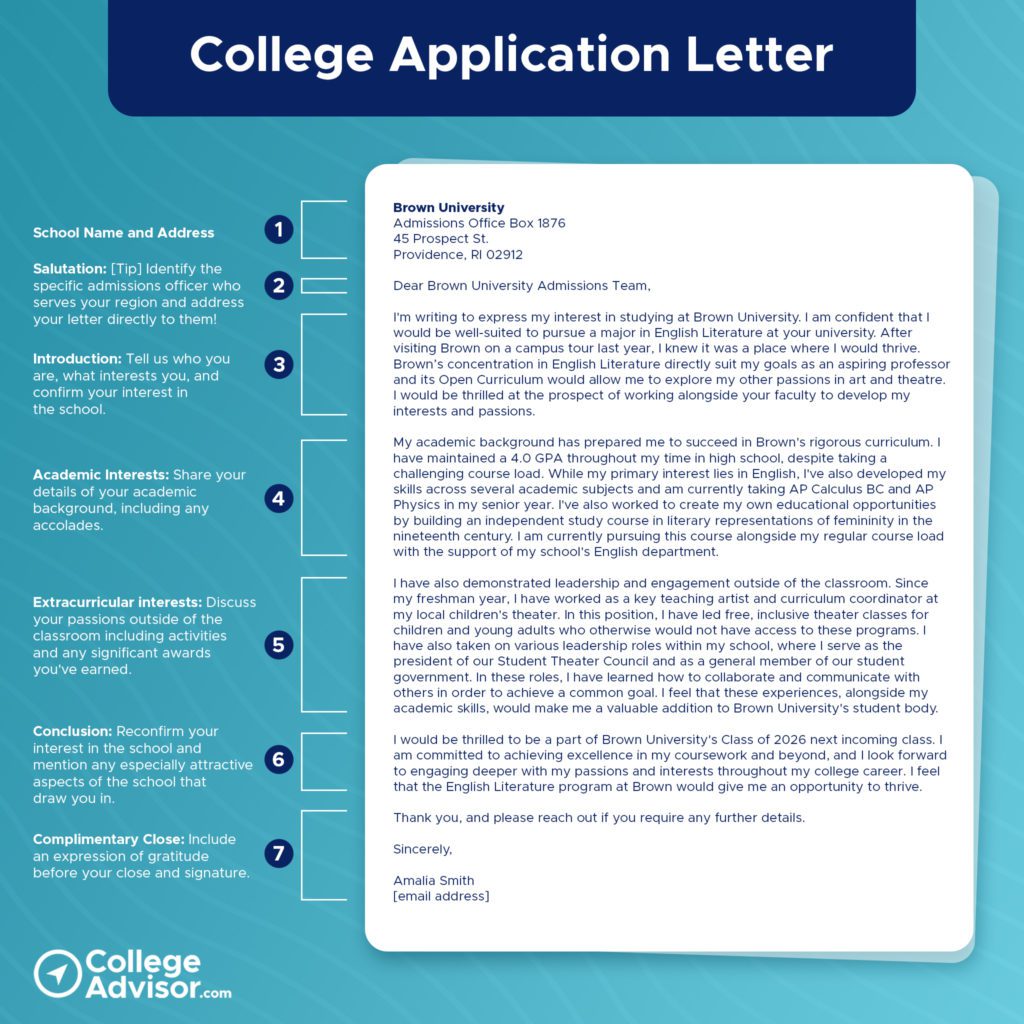
In the example of a college application letter above, there are a few key details to highlight. The letter is essentially a five-paragraph essay, with one paragraph for each of the five elements. This differs significantly from the college application essay format. In this college application example, the college application letter has clear and distinct sections, and this is very common in college application cover letter samples.
Depending on your interests and plans, you could take a more integrated approach. You’ll read some examples of college application letters that center around a theme or broad plan rather than separated into individual paragraphs.
This sample college application letter is a narrative. The applicant’s goal is to tell her story to the admissions committee. The best sample college application letters paint a picture for the reader and draw the reader into the storyline. Though it can feel like being vivid and descriptive is a waste of your space, “showing instead of telling makes for stronger college applications.
How to format your college application letter?
When reading sample college application letters, you’ll observe that they are formatted very similarly to professional cover letters. Your university application letters should be one page single-spaced. The heading should also be consistent across college application letters.
- Your full address
- The date you will send the letter
- The admission officer’s name
- The college name
- The college address
Then, open your letter with a salutation. Many examples of college application letters open with “Dear” and are addressed to the admission officer. If you cannot find your regional admissions officer, it is fine to address the letter to the admissions office as was done in the sample college application letter above. Once you write the body of your letter, don’t forget your closing salutation – “Sincerely,” and then your name.
Once you read several sample college application letters, you’ll understand the best practices. After writing a university application letter for one school, you don’t need to start from scratch for additional schools. Adapt what you have to fit the next college’s context and your specific interests on their campus.
Being concise is key. Your university application letter should not be redundant. If it exceeds one page, see where information you mention is repeated elsewhere in your application. In your cover letter, focus on the content that makes you as original and unique as possible. Most importantly, don’t forget to proofread your university application letters!
Can a college application letter help me with other parts of my application?
Think of the college application cover letter as the glue that holds your college applications together. When writing it, think about it as your opportunity to show your best self. After brainstorming the content, you’ll be better equipped to craft your candidate profile into a cohesive narrative and articulate why you want to attend the college.
Though many parts of your college applications will be out of your control by the time you reach your senior fall, the college application cover letter is one that you can control. Use it to elevate your college applications, show interest in your top schools , and make yourself stand out among other applicants!

The Letter of Continued Interest
Another form of college application letter is a letter of continued interest . In sample college application letters of continued interest, you’ll see that the primary purpose is to reaffirm your candidacy for a spot in the next incoming class of undergraduates.
Though it can feel like a waiting game, the waitlist should not be passive. As soon as you are waitlisted or deferred, begin crafting a letter of continued interest. The best college application sample LOCIs are submitted promptly. Put in the effort to show you’re serious about attending.
College application example LOCIs should focus on recent updates. Likely, a lot has happened since you submitted your application, particularly if you applied by the early deadlines. Strong college application sample LOCIs convey accomplishments and experiences that either add to previously mentioned ones or provide another dimension to your application.
Letter of continued interest – When and where to submit?
Learn as much as you can by reading college application example LOCIs, but know that each school’s process for when and how to submit them is different. Additionally, the process may vary based on whether you were deferred to the regular decision round of admissions or waitlisted after the regular decision round. It’s important to follow each university’s directions.
Many schools will request that you upload your letter of continued interest to a portal. Some will request that you email it to an address – typically the admissions office. Others won’t allow you to submit any additional materials. If you’re in doubt, call or email the admissions office and ask.
What to include in your letter of continued interest?
You’ll notice common trends when reading college application sample LOCIs. Effective college application example LOCIs convey a tone of sincerity, gratitude, and enthusiasm for an opportunity to attend. A strong sample college application letter of continued interest includes four elements.
First, reaffirm your interest in attending the school if offered the chance to matriculate. Then, discuss relevant developments to your application, such as additional extracurricular accolades and continued academic successes. Sometimes, you’ll see a sample college application letter of continued interest that mentions how a student improved a lower mid-year grade or discusses a new leadership role.
When reading a sample college application letter of continued interest, remember that colleges are looking for reasons to admit you, so don’t be shy! Offer to answer any questions they have and provide additional info in the conclusion of your letter.
It’s important to back up your claims with supporting evidence. Strong college application sample LOCIs provide examples and specific details, just as you would in a cover letter or essay. Be vivid and descriptive as you share your story!
However, college application example LOCIs that include overly emotional appeals or merely complement the university are unlikely to be effective. Your letter of continued interest should be all about you. Though it can be difficult to realize this when reading college application example LOCIs, recognize that the content of your letter should fit within the context of the rest of your application.
The many types of college application letters – Final Thoughts
In this guide, we covered several types of letters associated with your college process – college application cover letters, teacher recommendation letters, and letters of continued interest. Reading sample college application letters, whether they are college application cover letter samples or LOCIs, can help you do your best work. But, remember that every applicant’s college application process is unique.
Our final tips for writing college application letters:
- Proofread. College application letters with typos or grammatical errors reflect poorly on your effort and candidacy. Use a polished and professional tone in everything you write for your college applications.
- Be yourself. Though this goal can get lost in the requirements, scores, and grades, you should focus on helping the colleges on your list get to know who you are .
- Follow the requirements. Each college has their own requirements for how they want you to submit materials. Pay close attention to the details for each college as you go through the admissions process.
CollegeAdvisor.com can help guide you through every step of the college application process. Check out our blog , webinars , or register with CollegeAdvisor.com today. Good luck!

This guide to college application letters and letters of continued interest was written by Caroline Marapese, Notre Dame ‘22. At CollegeAdvisor, we have built our reputation by providing comprehensive information that offers real assistance to students. If you want to get help with your college applications from CollegeAdvisor.com Admissions Experts , click here to schedule a free meeting with one of our Admissions Specialists. During your meeting, our team will discuss your profile and help you find targeted ways to increase your admissions odds at top schools. We’ll also answer any questions and discuss how CollegeAdvisor.com can support you in the college application process.
Personalized and effective college advising for high school students.
- Advisor Application
- Popular Colleges
- Privacy Policy and Cookie Notice
- Student Login
- California Privacy Notice
- Terms and Conditions
- Your Privacy Choices
By using the College Advisor site and/or working with College Advisor, you agree to our updated Terms and Conditions and Privacy Policy , including an arbitration clause that covers any disputes relating to our policies and your use of our products and services.

Academic Cover Letters
What is this handout about.
The long list of application materials required for many academic teaching jobs can be daunting. This handout will help you tackle one of the most important components: the cover letter or letter of interest. Here you will learn about writing and revising cover letters for academic teaching jobs in the United States of America.
What is an academic cover letter?
An academic cover letter describes your experiences and interest as a candidate for a specific position. It introduces you to the hiring committee and demonstrates how your academic background fits with the description of the position.
What do cover letters for academic teaching jobs typically contain?
At their most basic level, academic cover letters accomplish three things: one, they express your interest in the job; two, they provide a brief synopsis of your research and teaching; and three, they summarize your past experiences and achievements to illustrate your competence for the job. For early-career scholars, cover letters are typically no more than two pages (up to four pages for senior scholars). Occasionally, a third page may make sense for an early-career scholar if the application does not require a separate teaching statement and/or research statement. Digital versions of cover letters often contain hyperlinks to your CV or portfolio page. For some fields, cover letters may also include examples of your work, including music, popular articles, and other multimedia related to your research, service, or teaching available online. Typically, letters appear on departmental or university letterhead and include your signature. Above all, a strong cover letter presents your accomplishments and your familiarity with the institution and with the position.
How should I prepare to write my academic cover letter?
Like all writing, composing a cover letter is a process. The process may be as short as a few hours or as long as several weeks, but at the end the letter should present you as a strong candidate for the job. The following section has tips and questions for thinking through each stage of this writing process. You don’t need to answer all of these questions to write the letter; they are meant to help you brainstorm ideas.
Before you begin writing your cover letter, consider researching the institution, the department, and the student population. Incorporating all three aspects in your letter will help convey your interest in the position.
Get to know the institution. When crafting your cover letter, be aware of the type of institution to which you are applying. Knowing how the institution presents itself can help you tailor your letter and make it more specific.
- Where is the institution located?
- Is it on a quarter-system or semester-system?
- What type of institution is it? Is it an R1? Is it an R2? Is it a liberal arts college? Is it an HBCU? Is it a community college? A private high school?
- What is the institution’s culture? Is it teaching-focused or research-focused? Does it privilege experiential learning? Does it value faculty involvement outside the classroom? Is it affiliated with a specific religious tradition?
- Does it have any specific institutional commitments?
- How does the institution advocate for involvement in its local community?
- What are the professional development opportunities for new and junior faculty?
Learn about the department. Knowing the specific culture and needs of the department can help you reach your audience: the department members who will be reading your documents and vetting you as a candidate.
- Who is on the search committee? Who is the search committee chair?
- What is the official name of the department?
- Which different subfields make up the department?
- Is it a dual appointment or a position in a dual department?
- How does the department participate in specific types of student outreach?
- Does the department have graduate students? Does it offer a terminal Master’s degree, Ph.D., or both? How large are the cohorts? How are they funded?
- Does the department encourage or engage in interdisciplinary work?
- Does the majority of the department favor certain theoretical or methodological approaches?
- Does the department have partnerships with local institutions? If so, which ones?
- Is the department attempting to fill a specific vacancy, or is it an entirely new position?
- What are the typical course offerings in the department? Which courses might you be expected to teach? What courses might you be able to provide that are not currently available?
Consider the students. The search committee will often consider how you approach instructing and mentoring the student body. Sometimes committees will even reserve a position for a student or solicit student feedback on a candidate:
- What populations constitute the majority of the undergraduate population?
- Have there been any shifts in the student population recently?
- Do students largely come from in-state or out-of-state?
- Is there an international student population? If so, from which countries?
- Is the university recruiting students from traditionally underrepresented populations?
- Are students particularly active on campus? If so, how?
Many answers to these questions can be found both in the job description and on the institution’s website. If possible, consider contacting someone you know at the institution to ask about the culture directly. You can also use the institution’s course catalog, recruitment materials, alumni magazine, and other materials to get answers to these questions. The key is to understand the sort of institution to which you are applying, its immediate needs, and its future trajectory.
Remember, there is a resource that can help you with all three aspects—people. Reach out to your advisor, committee members, faculty mentors, and other contacts for insight into the prospective department’s culture and faculty. They might even help you revise your letter based on their expertise. Think of your job search as an opportunity to cultivate these relationships.
After you have done some initial research, think about how your experiences have prepared you for the job and identify the ones that seem the most relevant. Consider your previous research, internships, graduate teaching, and summer experiences. Here are some topics and questions to get you started thinking about what you might include.
Research Experiences. Consider how your research has prepared you for an academic career. Since the letter is a relatively short document, select examples of your research that really highlight who you are as a scholar, the direction you see your work going, and how your scholarship will contribute to the institution’s research community.
- What are your current research interests?
- What topics would you like to examine in the future?
- How have you pursued those research interests?
- Have you traveled for your research?
- Have you published any of your research? Have you presented it at a conference, symposium, or elsewhere?
- Have you worked or collaborated with scholars at different institutions on projects? If so, what did these collaborations produce?
- Have you made your research accessible to your local community?
- Have you received funding or merit-based fellowships for your research?
- What other research contributions have you made? This may include opinion articles, book chapters, or participating as a journal reviewer.
- How do your research interests relate to those of other faculty in the department or fill a gap?
Teaching Experience. Think about any teaching experience you may have. Perhaps you led recitations as a teaching assistant, taught your own course, or guest lectured. Pick a few experiences to discuss in your letter that demonstrate something about your teaching style or your interest in teaching.
- What courses are you interested in teaching for the department? What courses have you taught that discussed similar topics or themes?
- What new courses can you imagine offering the department that align with their aim and mission?
- Have you used specific strategies that were helpful in your instruction?
- What sort of resources do you typically use in the classroom?
- Do you have anecdotes that demonstrate your teaching style?
- What is your teaching philosophy?
- When have you successfully navigated a difficult concept or topic in the classroom, and what did you learn?
- What other opportunities could you provide to students?
Internships/Summer/Other Experiences. Brainstorm a list of any conferences, colloquiums, and workshops you have attended, as well as any ways you have served your department, university, or local community. This section will highlight how you participate in your university and scholarly community. Here are some examples of things you might discuss:
- Professional development opportunities you may have pursued over the summer or during your studies
- International travel for research or presentations
- Any research you’ve done in a non-academic setting
- Presentations at conferences
- Participation in symposia, reading groups, working groups, etc.
- Internships in which you may have implemented your research or practical skills related to your discipline
- Participation in community engagement projects
- Participation in or leadership of any scholarly and/or university organizations
In answering these questions, create a list of the experiences that you think best reflect you as a scholar and teacher. In choosing which experiences to highlight, consider your audience and what they would find valuable or relevant. Taking the time to really think about your reader will help you present yourself as an applicant well-qualified for the position.
Writing a draft
Remember that the job letter is an opportunity to introduce yourself and your accomplishments and to communicate why you would be a good fit for the position. Typically, search committees will want to know whether you are a capable job candidate, familiar with the institution, and a great future addition to the department’s faculty. As such, be aware of how the letter’s structure and content reflect your preparedness for the position.
The structure of your cover letter should reflect the typical standards for letter writing in the country in which the position is located (the list below reflects the standards for US letter writing). This usually includes a salutation, body, and closing, as well as proper contact information. If you are affiliated with a department, institution, or organization, the letter should be on letterhead.
- Use a simple, readable font in a standard size, such as 10-12pt. Some examples of fonts that may be conventional in your field include Arial, Garamond, Times New Roman, and Verdana, among other similar fonts.
- Do not indent paragraphs.
- Separate all paragraphs by a line and justify them to the left.
- Make sure that any included hyperlinks work.
- Include your signature in the closing.
Before you send in your letter, make sure you proofread and look for formatting mistakes. You’ll read more about proofreading and revising later in this handout!
The second most important aspect of your letter is its content. Since the letter is the first chance to provide an in-depth introduction, it should expand on who you are as a scholar and possible faculty member. Below are some elements to consider including when composing your letter.
Identify the position you are applying to and introduce yourself. Traditionally, the first sentence of a job letter includes the full name of the position and where you discovered the job posting. This is also the place to introduce yourself and describe why you are applying for this position. Since the goal of a job letter is to persuade the search committee to include you on the list of candidates for further review, you may want to include an initial claim as to why you are a strong candidate for the position. Some questions you might consider:
- What is your current status (ABD, assistant professor, post-doc, etc.)?
- If you are ABD, have you defended your dissertation? If not, when will you defend?
- Why are you interested in this position?
- Why are you a strong candidate for this position?
Describe your research experience and interests. For research-centered positions, such as positions at R1 or other types of research-centered universities, include information about your research experience and current work early in the letter. For many applicants, current work will be the dissertation project. If this is the case, some suggest calling your “dissertation research” your “current project” or “work,” as this may help you present yourself as an emerging scholar rather than a graduate student. Some questions about your research that you might consider:
- What research experiences have you had?
- What does your current project investigate?
- What are some of the important methods you applied?
- Have you collaborated with others in your research?
- Have you acquired specific skills that will be useful for the future?
- Have you received special funding? If so, what kind?
- Has your research received any accolades or rewards?
- What does your current project contribute to the field?
- Where have you presented your research?
- Have you published your research? If so, where? Or are you working on publishing your work?
- How does your current project fit the job description?
Present your plans for future research. This section presents your research agenda and usually includes a description of your plans for future projects and research publications. Detailing your future research demonstrates to the search committee that you’ve thought about a research trajectory and can work independently. If you are applying to a teaching-intensive position, you may want to minimize this section and/or consider including a sentence or two on how this research connects to undergraduate and/or graduate research opportunities. Some questions to get you started:
- What is your next research project/s?
- How does this connect to your current and past work?
- What major theories/methods will you use?
- How will this project contribute to the field?
- Where do you see your specialty area or subfield going in the next ten years and how does your research contribute to or reflect this?
- Will you be collaborating with anyone? If so, with whom?
- How will this future project encourage academic discourse?
- Do you already have funding? If so, from whom? If not, what plans do you have for obtaining funding?
- How does your future research expand upon the department’s strengths while simultaneously diversifying the university’s research portfolio? (For example, does your future research involve emerging research fields, state-of-the-art technologies, or novel applications?)
Describe your teaching experience and highlight teaching strategies. This section allows you to describe your teaching philosophy and how you apply this philosophy in your classroom. Start by briefly addressing your teaching goals and values. Here, you can provide specific examples of your teaching methods by describing activities and projects you assign students. Try to link your teaching and research together. For example, if you research the rise of feminism in the 19th century, consider how you bring either the methodology or the content of your research into the classroom. For a teaching-centered institution, such as a small liberal arts college or community college, you may want to emphasize your teaching more than your research. If you do not have any teaching experience, you could describe a training, mentoring, or coaching situation that was similar to teaching and how you would apply what you learned in a classroom.
- What is your teaching philosophy? How is your philosophy a good fit for the department in which you are applying to work?
- What sort of teaching strategies do you use in the classroom?
- What is your teaching style? Do you lecture? Do you emphasize discussion? Do you use specific forms of interactive learning?
- What courses have you taught?
- What departmental courses are you prepared to teach?
- Will you be able to fill in any gaps in the departmental course offerings?
- What important teaching and/or mentoring experiences have you had?
- How would you describe yourself in the classroom?
- What type of feedback have you gotten from students?
- Have you received any awards or recognition for your teaching?
Talk about your service work. Service is often an important component of an academic job description. This can include things like serving on committees or funding panels, providing reviews, and doing community outreach. The cover letter gives you an opportunity to explain how you have involved yourself in university life outside the classroom. For instance, you could include descriptions of volunteer work, participation in initiatives, or your role in professional organizations. This section should demonstrate ways in which you have served your department, university, and/or scholarly community. Here are some additional examples you could discuss:
- Participating in graduate student or junior faculty governance
- Sitting on committees, departmental or university-wide
- Partnerships with other university offices or departments
- Participating in community-partnerships
- Participating in public scholarship initiatives
- Founding or participating in any university initiatives or programs
- Creating extra-curricular resources or presentations
Present yourself as a future faculty member. This section demonstrates who you will be as a colleague. It gives you the opportunity to explain how you will collaborate with faculty members with similar interests; take part in departmental and/or institution wide initiatives or centers; and participate in departmental service. This shows your familiarity with the role of faculty outside the classroom and your ability to add to the departmental and/or institutional strengths or fill in any gaps.
- What excites you about this job?
- What faculty would you like to collaborate with and why? (This answer may be slightly tricky. See the section on name dropping below.)
- Are there any partnerships in the university or outside of it that you wish to participate in?
- Are there any centers associated with the university or in the community that you want to be involved in?
- Are there faculty initiatives that you are passionate about?
- Do you have experience collaborating across various departments or within your own department?
- In what areas will you be able to contribute?
- Why would you make an excellent addition to the faculty at this institution?
Compose a strong closing. This short section should acknowledge that you have sent in all other application documents and include a brief thank you for the reader’s time and/or consideration. It should also state your willingness to forward additional materials and indicate what you would like to see as next steps (e.g., a statement that you look forward to speaking with the search committee). End with a professional closing such as “Sincerely” or “Kind Regards” followed by your full name.
If you are finding it difficult to write the different sections of your cover letter, consider composing the other academic job application documents (the research statement, teaching philosophy, and diversity statement) first and then summarizing them in your job letter.
Different kinds of letters may be required for different types of jobs. For example, some jobs may focus on research. In this case, emphasize your research experiences and current project/s. Other jobs may be more focused on teaching. In this case, highlight your teaching background and skills. Below are two models for how you could change your letter’s organization based on the job description and the institution. The models offer a guide for you to consider how changing the order of information and the amount of space dedicated to a particular topic changes the emphasis of the letter.
Research-Based Position Job Letter Example:
Teaching-based position job letter example:.
Remember your first draft does not have to be your last. Try to get feedback from different readers, especially if it is one of your first applications. It is not uncommon to go through several stages of revisions. Check out the Writing Center’s handout on editing and proofreading and video on proofreading to help with this last stage of writing.
Potential pitfalls
Using the word dissertation. Some search committee members may see the word “dissertation” as a red flag that an applicant is too focused on their role as a graduate student rather than as a prospective faculty member. It may be advantageous, then, to describe your dissertation as current research, a current research project, current work, or some other phrase that demonstrates you are aware that your dissertation is the beginning of a larger scholarly career.
Too much jargon. While you may be writing to a specific department, people on the search committee might be unfamiliar with the details of your subfield. In fact, many committees have at least one member from outside their department. Use terminology that can easily be understood by non-experts. If you want to use a specific term that is crucial to your research, then you should define it. Aim for clarity for your reader, which may mean simplification in lieu of complete precision.
Overselling yourself. While your job letter should sell you as a great candidate, saying so (e.g., “I’m the ideal candidate”) in your letter may come off to some search committee members as presumptuous. Remember that although you have an idea about the type of colleague a department is searching for, ultimately you do not know exactly what they want. Try to avoid phrases or sentences where you state you are the ideal or the only candidate right for the position.
Paying too much attention to the job description. Job descriptions are the result of a lot of debate and compromise. If you have skills or research interests outside the job description, consider including them in your letter. It may be that your extra research interests; your outside skills; and/or your extracurricular involvements make you an attractive candidate. For example, if you are a Latin Americanist who also happens to be well-versed in the Spanish Revolution, it could be worth mentioning the expanse of your research interests because a department might find you could fill in other gaps in the curriculum or add an additional or complementary perspective to the department.
Improper sendoff. The closing of your letter is just as important as the beginning. The end of the letter should reflect the professionalism of the document. There should be a thank-you and the word sincerely or a formal equivalent. Remember, it is the very last place in your letter where you present yourself as a capable future colleague.
Small oversights. Make sure to proofread your letter not just for grammar but also for content. For example, if you use material from another letter, make sure you do not include the names of another school, department, or unassociated faculty! Or, if the school is in Chicago, make sure you do not accidentally reference it as located in the Twin Cities.
Name dropping. You rarely know the internal politics of the department or institution to which you are applying. So be cautious about the names you insert in your cover letters. You do not want to unintentionally insert yourself into a departmental squabble or add fire to an interdepartmental conflict. Instead, focus on the actions you will undertake and the initiatives you are passionate about.
Works consulted
We consulted these works while writing this handout. This is not a comprehensive list of resources on the handout’s topic, and we encourage you to do your own research to find additional publications. Please do not use this list as a model for the format of your own reference list, as it may not match the citation style you are using. For guidance on formatting citations, please see the UNC Libraries citation tutorial . We revise these tips periodically and welcome feedback.
Ball, Cheryl E. 2013. “Understanding Cover Letters.” Inside Higher Ed , November 3, 2013. https://www.insidehighered.com/advice/2013/11/04/essay-cover-letter-academic-jobs .
Borchardt, John. 2014. “Writing a Winning Cover Letter.” Science Magazine , August 6, 2014. https://www.sciencemag.org/careers/2014/08/writing-winning-cover-letter# .
Helmreich, William. 2013. “Your First Academic Job.” Inside Higher Ed , June 17, 2013. https://www.insidehighered.com/advice/2013/06/17/essay-how-land-first-academic-job .
Kelsky, Karen. 2013. “How To Write a Journal Article Submission Cover Letter.” The Professor Is In (blog), April 26, 2013. https://theprofessorisin.com/2013/04/26/how-to-write-a-journal-article-submission-cover-letter/ .
Tomaska, Lubomir, and Josef Nosek. 2008. “Ten Simple Rules for Writing a Cover Letter to Accompany a Job Application for an Academic Position.” PLoS Computational Biology 14(5). https://doi.org/10.1371/journal.pcbi.1006132 .
You may reproduce it for non-commercial use if you use the entire handout and attribute the source: The Writing Center, University of North Carolina at Chapel Hill
Make a Gift
Purdue Online Writing Lab Purdue OWL® College of Liberal Arts
Academic Cover Letter Sample

Welcome to the Purdue OWL
This page is brought to you by the OWL at Purdue University. When printing this page, you must include the entire legal notice.
Copyright ©1995-2018 by The Writing Lab & The OWL at Purdue and Purdue University. All rights reserved. This material may not be published, reproduced, broadcast, rewritten, or redistributed without permission. Use of this site constitutes acceptance of our terms and conditions of fair use.
When you're applying for a faculty position with a college or university, the cover letter is your first chance to make a strong impression as a promising researcher and teacher. Below you'll find some strategies for presenting your qualifications effectively in an academic context.
November 2, 1998
Dr. Naomi Sellers Chair, English Search Committee Box 58 Baxter College Arcadia, WV 24803
Dear Dr. Sellers:
I am writing to apply for the position as assistant professor of English with an emphasis in rhetoric and composition that you advertised in the October MLA Job Information List. I am a graduate student at Prestigious University working on a dissertation under the direction of Professor Prominent Figure. Currently revising the third of five chapters, I expect to complete all work for the Ph.D. by May of 1999. I believe that my teaching and tutoring experience combined with my course work and research background in rhetoric and composition theory make me a strong candidate for the position outlined in your notice.
As my curriculum vitae shows, I have had excellent opportunities to teach a variety of writing courses during my graduate studies, including developmental writing, first-year writing for both native speakers and second language students, advanced writing, and business writing. I have also worked as a teaching mentor for new graduate students, a position that involved instruction in methods of composition teaching, development of course materials, and evaluation of new graduate instructors. Among the most satisfying experiences for me as a teacher has been instructing students on an individual basis as a tutor in our university Writing Lab. Even as a classroom instructor, I find that I always look forward to the individual conferences that I hold with my students several times during the semester because I believe this kind of one-on-one interaction to be essential to their development as writers.
My work in the composition classroom has provided me with the inspiration as well as a kind of laboratory for my dissertation research. My project, The I Has It: Applications of Recent Models of Subjectivity in Composition Theory, examines the shift since the 1960s from expressive models of writing toward now-dominant postmodern conceptions of decentered subjectivity and self-construction through writing. I argue that these more recent theoretical models, while promising, cannot have the liberating effects that are claimed for them without a concomitant reconception of writing pedagogy and the dynamics of the writing classroom. I relate critical readings of theoretical texts to my own pedagogical experiments as a writing teacher, using narratives of classroom successes and failures as the bases for critical reflection on postmodern composition theory. After developing my dissertation into a book manuscript, I plan to continue my work in current composition theory through a critical examination of the rhetoric of technological advancement in the computer-mediated writing classroom.
My interest in the computer classroom has grown out of recent experience teaching composition in that environment. In these courses my students have used computers for writing and turning in notes and essays, communicating with one another and with me, conducting library catalogue research and web research, and creating websites. I have encouraged my students to think and write critically about their experiences with technology, both in my class and elsewhere, even as we have used technology to facilitate our work in the course. Syllabi and other materials for my writing courses can be viewed at my website: http://machine.prestigious.edu/~name. In all of my writing courses I encourage students to become critical readers, thinkers, and writers; my goal is always not only to promote their intellectual engagement with cultural texts of all kinds but also to help them become more discerning readers of and forceful writers about the world around them.
I have included my curriculum vitae and would be happy to send you additional materials such as a dossier of letters of reference, writing samples, teaching evaluations, and past and proposed course syllabi. I will be available to meet with you for an interview at either the MLA or the CCCC convention, or elsewhere at your convenience. I can be reached at my home phone number before December 19; between then and the start of the MLA convention, you can reach me at (123) 456-7890. I thank you for your consideration and look forward to hearing from you.
First Lastname
Points to Remember
- Use the form of address and title of the contact person as they appear in the job notice.
- Refer to the job title as it appears in the notice, and state where you learned of the position.
- Mention your major professor by name, especially if he or she is well known in your field. Also, mention your expected completion date.
- Make a claim for your candidacy that you will support in the body of the letter.
- For a position at a small undergraduate college, emphasize teaching experience and philosophy early in the letter.
- Describe your dissertation and plans for future research. Emphasize links between your teaching and research interests.
- Mention specific teaching experience that is relevant to the job notice or is otherwise noteworthy.
- Refer to relevant materials available on the web.
- State your willingness to forward additional materials and to meet for an interview.
- Mention any temporary changes in contact information.
Home / Guides / Writing Guides / Parts of a Paper / How to Write an Essay Cover Page
How to Write an Essay Cover Page
What you include in your cover page depends slightly on which citation style you are using, but the rules are generally the same.
Guide Overview
- APA cover pages
- MLA cover pages
For APA cover pages:
Include the title of the paper, running head, the author’s name, institutional affiliation, and an author’s note.
Here is an example of a cover page in APA:

For MLA cover pages:
Cover pages are not as frequently used in MLA format, as the inclusion of headers is preferred.
A header looks like this:

Cover pages can include the name of your school, your paper title, your name, your course name, your teacher or professor’s name, and the due date of the paper. If you are unsure of what to include, check with your instructor.
Here is an example of a cover page in MLA format:

For more help making cover or title pages, visit our title page generator here.
EasyBib Writing Resources
Writing a paper.
- Academic Essay
- Argumentative Essay
- College Admissions Essay
- Expository Essay
- Persuasive Essay
- Research Paper
- Thesis Statement
- Writing a Conclusion
- Writing an Introduction
- Writing an Outline
- Writing a Summary
EasyBib Plus Features
- Citation Generator
- Essay Checker
- Expert Check Proofreader
- Grammar Checker
- Paraphrasing Tools
Plagiarism Checker
- Spell Checker
How useful was this post?
Click on a star to rate it!
We are sorry that this post was not useful for you!
Let us improve this post!
Tell us how we can improve this post?
Grammar and Plagiarism Checkers
Grammar Basics
Plagiarism Basics
Writing Basics
Upload a paper to check for plagiarism against billions of sources and get advanced writing suggestions for clarity and style.
Get Started

IMAGES
VIDEO
COMMENTS
Example cover letter for an essay Here is an example of what a quality essay cover letter might look like: Lili Eaglestone 123 Luna Lane Los Angeles, CA December 18, 2022 Dear Admissions Committee, My name is Lili Eaglestone, and I am applying to become a student at the University of Southern California for fall 2023. Writing my application essay was a delight, as I am very passionate about ...
12. End with a positive note. If you wish to explicitly demonstrate your positive values, do not hesitate to write a short piece of pleasantry toward the end of your cover letter. Again, it is needless to say that you have to maintain a formal yet non-pretentious tone in writing this part of your letter.
An Essay Cover Letter is a brief introduction accompanying an essay, typically submitted to an academic institution or a publication. It summarizes the content and purpose of the essay, highlights the writer's qualifications, and expresses the intention behind submitting the essay. ... Essay Cover Letter for College Student Example.
Including a good cover letter with your college admissions essay can be as valuable as the actual essay. While the essay should showcase your vocabulary, organization and logic skills, the cover letter is an opportunity to discuss what inspired you to pick your topic and to highlight the most relevant parts of your ...
The purpose of college application cover letters, college entrance essays, and college resumes is to persuade colleges that you are the strongest candidate for admissions. College application cover letters are not the time to be shy, but they're not the time to be pretentious either. When reading college application cover letter examples, you ...
At their most basic level, academic cover letters accomplish three things: one, they express your interest in the job; two, they provide a brief synopsis of your research and teaching; and three, they summarize your past experiences and achievements to illustrate your competence for the job. For early-career scholars, cover letters are ...
Crafting a Successful Cover Letter. To stand out, a cover letter must be outstanding: smart, engaging, concrete, detailed and polished to perfection. Melissa Dennihy gives pointers on how to do that. With the academic job market season in full swing, prospective hires are sending off cover letters to apply for highly competitive faculty positions.
1. The Introduction. The tradition for including the full name and position number, if there is one, and location where you discovered the job posting feels odd, but it's a standard opening line to your letter. Also in this paragraph, you should state what your current status is (ABD, defending in April, assistant professor, etc.).
Make sure that the title, name and address of a person or the company in salutations are accurate. A cover begins with a greeting, addressed to the hiring committee or a specific individual if the name is mentioned in the job advertisement. Then the body of the letter should start by stating the job title and job number you are applying to.
Academic Cover Letter Sample. November 2, 1998. Dr. Naomi Sellers. Chair, English Search Committee. Box 58. Baxter College. Arcadia, WV 24803. Dear Dr. Sellers: I am writing to apply for the position as assistant professor of English with an emphasis in rhetoric and composition that you advertised in the October MLA Job Information List.
Content. Top ↑ College Student Cover Letter Example 5 Steps for the Perfect College Student Cover Letter #1. Put Contact Information in the Header #2. Address the Hiring Manager #3. Write an Eye-Catching Opening Statement #4. Use the Cover Letter Body for the Details #5.
Sample Cover Letter for a College Student—Structure Checklist. Your contact info in a sharp header. The company's contact info. Dear (hiring manager's name) Paragraph #1: introduction and an achievement that's tailored to the job. Paragraph #2: key skills and why you fit the job. Paragraph #3: your passion + why you want in.
After you write a good opening statement, continue describing your motivations for applying in 2-3 more paragraphs. And consider adding a bulleted list to make your motivation letter easier to read. 3. Close strong. End your letter of motivation with a paragraph that: thanks the reader for going through your letter.
Here are tips on how to format your cover letter properly: Include an introduction, two to three body paragraphs, and a conclusion. Keep the font size between 10.5 and 12 points (be sure to choose a professional cover letter font). Make sure the margins are ½"-1" on all sides side. 3. Open with a strong introduction.
The basics of a cover letter boil down to this outline: An introductory paragraph (who you are, why this company and this job, and a bridge between the two) One or two themed paragraphs (highlighting and showing you have skills that match the job)
Again, we'd recommend sticking with standard fonts and sizes—Times New Roman, 12-point is a standard workhorse. You can probably go with 1.5 or double spacing. Standard margins. Basically, show them you're ready to write in college by using the formatting you'll normally use in college.
Cover pages can include the name of your school, your paper title, your name, your course name, your teacher or professor's name, and the due date of the paper. If you are unsure of what to include, check with your instructor. Here is an example of a cover page in MLA format: For more help making cover or title pages, visit our title page ...
Example cover letter for a scholarship. Consider this example of a cover letter for a scholarship to help guide you as you write: Dear Ms. Adams, My name is Eloise Barone, and I'm writing to submit my application for the Ridge Hills University financial aid program for the spring 2024 semester. I'm currently a first-year student enrolled in the ...
A fill-in-the-blanks template that will produce your cover letter for scholarship within 15 minutes. Save hours of work and get a cover letter like this. Pick a template, fill it in. Quick and easy. Choose from 18+ cover letter templates and download your cover letter now. Create your cover letter now.
Cover letter format. Your cover letter should be one page long and use a simple, professional font, such as Arial or Helvetica, 10 to 12 points in size. Your letter should be left-aligned with single spacing and one-inch margins. Video: When and Why to Write a Cover Letter - Plus, Top Tips for Formatting.